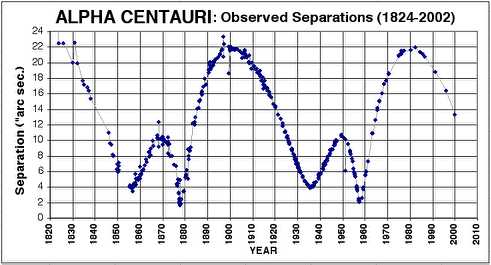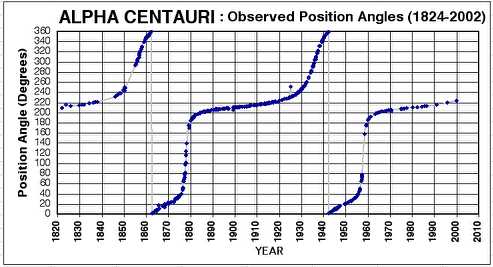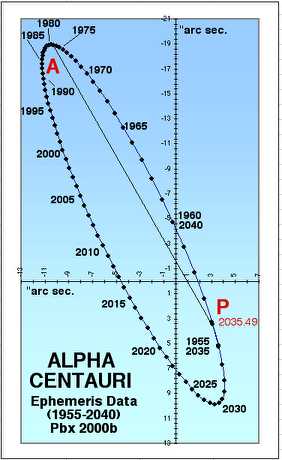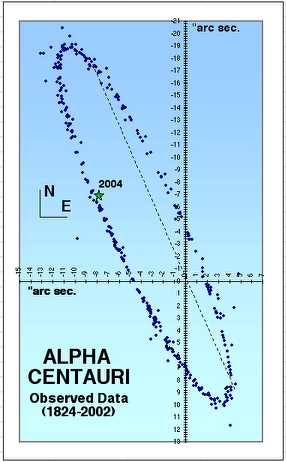



THE title of Imperial Star should really be imperial stars as if sharing the throne as the king and queen.
The third brightest star in the sky, lying two hours in Right Ascension east of the Cross is Alpha (α) Centauri. For some odd reason northern authors will often place Rigel Kent behind the first magnitude star Arcturus — and this is often slyly done by just individually listing the two stars. Either way, α Cen combined and α Cen “A” are brighter than Arcturus.
Alpha Centauri in the sky lies within a bright part of the Milky Way, so the telescopic field contains many background stars.
| COMPONENT |
Alpha Cen A HIP 71683 SAO 252838A |
Alpha Cen B HIP 71681 SAO 252838B |
Alpha Cen C Proxima Centauri |
| R.A. (2000) | 14h 39′ 40.90″ | 14h 39′ 39.39″ | 14h 29′ 47.750″ |
| Dec. (2000) | -60° 50′ 00.65″ | -60° 50′ 22.10″ | -60° 42′ 52.90″ |
| Solar Mass (M⊙) | 1.07 | 0.87 | 0.107±0.021 |
| Spectral Class | G2V | K1V | M5VIIe |
| Total Mag. | -0.29 | 12.1 - 13.12 B | |
| App.Mag. (v.) | -0.04 | 1.35 | 11.01(var) |
| Abs.Mag. (MV) | +4.38 | +5.74 | +15.4 |
| B−V Mag. | 0.71 | 0.9 | 1.807 |
| Luminosity (L★/L⊙) | 1.522±0.030 | 0.503±0.020 | |
| Bolometric Correction (BC) | -0.059±0.041 | -0.194±0.021 | |
| Temperature (Teff) (K) | 5790±30 | 5260±50 | 3000 |
| Iron/ Hydrogen [Fe/H]s | 0.22±0.05 | 0.24±0.05 | -- |
| Age (G.yr.)) | 6.52±0.30 | ? | |
| Radii (R⊙) | 1.224±0.003 | 0.863±0.005 | 0.35 |
| Angular Diameter (θA/θB) (mas.) | 8.511±0.020 | 6.001±0.034 | 1.66±0.02 |
| Mass (M⊙) | 1.105±0.0070 | 0.934±0.0061 | 0.15±0.02 |
| Separation (AU) | 35 (Max) and 8.5 (Min) | 13 000 | |
| Radial Velocity (RV) (km.s.-1) | -22.7 (mean) | -15.7±3.3 | |
| Galactic Velocity (km.s.-1) | {U}= -12.7, {V}= -22.4, {W}= -8.0 | ||
| Proper Motion(pmRA.) (mas.) | -3 678.19±1.510 | -3 600.35±26.10 | -3 775.64 |
| Proper Motion (pmDec.) (mas.) | +481.84±1.24 | +952.11±19.75 | +768.16±1.82 |
| Distance (pc.) | 1.3478±0.002 5 | 1.3478±0.002 7 | 1.295 |
| Distance (ly.) | 4.3964 | 4.223 | |
| Period (Years) | 79.92 | 100 000 | |
| Parallax (mas.) | 742.12±1.40 | 742.12±1.41 | 772.33±2.42 |
| GENERAL NOTES | |||
| 1: Distances here are quoted from calculations made by Jahreiss and Morrison (1993) using the Gliese Catalogue, which specialises with the closest stars to the Sun.) | |||
| 2: Proper Motion can be either expressed in terms of mas (milliarcsec.) per year, arcsec per Century OR even in arcsec per decayear (10 years) (″d.yr-1) | |||
| 3: Proxima is a UV Cet Type Variable named V645 Cen. | |||
| Orbital Elements of Main “A × B”
System |
||||||
| P | T | e | a | i | Ω | ω |
| 79.906 yr. | 1955.607 | 0.519 | 17.537″ | 79.327° | 205.023° | 231.897° |
Based on these rough estimates, this can be seen graphically in Figure 1-1, showing separation versus time.


 |
 |
Alpha Centauri / RHD 1AB |
|||
| WDS 14396-6050 | |||
| HIP 71681 | HIP 71683 | Right Ascension 14h 39m 40.9s (2000) |
Declination –60° 50′ 06.5″ (2000) |
| Mag. A = –0.01V | Mag. B = +1.35V | Orbital Elements | |
| Element |
Finsen (1926) |
Heinze (1955) |
Pourbaix (2002a) |
| T | 1875.789 | 1955.56 | 1875.663 |
| P | 80.089 | 79.92 | 79.914 |
| a | 17.665 | 17.515 | 17.575 |
| e | 0.521 | 0.516 | 0.5179 |
| i | 79.223 | 79.240 | 79.205 |
| Ω | 205.443 | 204.87 | 204.849 |
| ω | 232.132 | 231.56 | 231.651 |
| Grade | ? | 1 | 2 |
| Thiele-Innes Constants |
|||
| A | 8.6713 | 8.8020 | 8.8100 |
| B | 7.0132 | 6.9032 | 6.9249 |
| C | -13.6993 | -13.4776 | -13.5392 |
| F | -13.4638 | -13.3015 | -13.3653 |
| G | -4.1601 | -3.9252 | -3.9388 |
| H | -10.6523 | -10.6975 | -10.7114 |
The older orbital elements were produced by W.D. Heintz and were used in the 3rd, 4th and 5th ‘Catalogues of Orbits of Visual Binary Stars’. These values are considered to be accurate between the years 1950 to 2000. In the US Naval Observatory (USNO) ‘Sixth Catalog of Orbits of Visual Binary Stars: Orbital Elements’, these are referenced as Hei1958, but the final element were actually published in Veroff. Sternw. Munchen., 5, 100 (1960). The next orbital elements with a higher precision were added to the 6th Orbit Catalogue. These appeared in the 2002 paper published in Astronomy and Astrophysics by collaboration, whose first name is listed as the Belgian observer D. Pourbaix. These observers were able to measure and reevaluated the blueshift between the two components then compared them to quality radial velocities.” This is abbreviated in the WDS Reference file as Pbx2000b. One of the main differences is the quality grade of the orbit, which has been downgraded to 2.
| Perihelion |
Aphelion |
||
| Hei1958 | Pbx2000b | Hei1958 | Pbx2000b |
| 1797.08 | 1795.749 | 1836.70 | 1835.706 |
| 1876.32 | 1875.663 | 1915.94 | 1915.620 |
| 1955.56 | 1955.577 | 1995.18 | 1995.534 |
| 2034.80 | 2035.491 | 2074.42 | 2075.448 |
| 2114.04 | 2115.405 | ||
Southern Astronomical Delights © (2010)